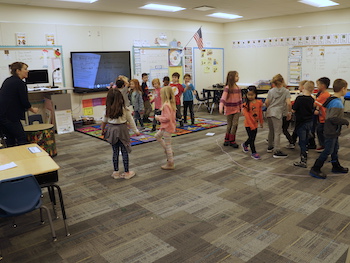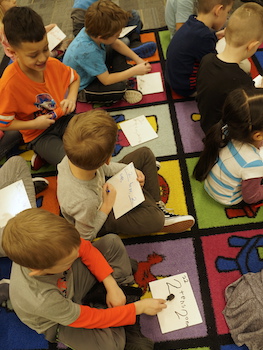SUBJECTS
GRADE
Show Results
Every Dancer Counts!
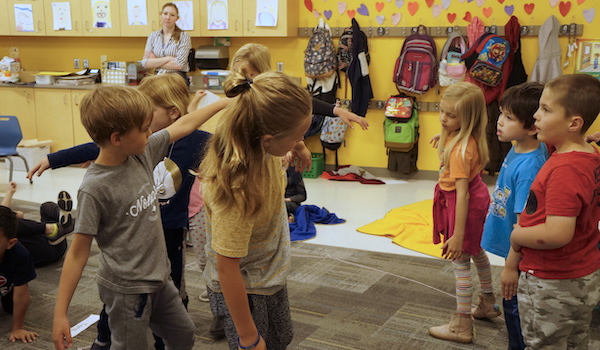
Lesson Summary
- Create a place-value dance to represent ones and tens through percussive-axial movements and sustained-locomotor movements.
- Write numbers modeling tens and ones in various ways.
Lesson Plan and Procedure
Lesson Key Facts
- Grade(s): K, 1, 2
- Subject(s): Dance
- Duration of lesson: 45 minutes
- Author(s): Lisa Garner
Note: This lesson requires open space to move. It can be done in a classroom, but the desks will need to be pushed to the side.
Learning Dance Elements
Teacher: Today we will be using movement to show tens and ones. In dance there are ways we can move our bodies without traveling around the room. When we stay in one place, this is called axial movement. With axial movement, at least one part of your body is anchored to the floor, but you can move the rest of your body in any direction around you.
Show the dance vocabulary word card and model axial movements for the students.
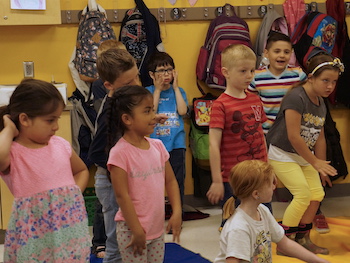
Side-coach the students to experiment with moving individual parts of their bodies, their upper bodies, their lower bodies, and their entire bodies in axial movements. Have the students freeze and then sit down, ready to listen.
Teacher: There are also movements in which we travel from one location to another. This is called locomotor movement.
Show the dance vocabulary word card and model locomotor movements for the students.
Teacher: To use locomotor movements, we might walk, run, jump, hop, skip, slide, or gallop. (Students might think of other ways besides these in which they can move from one space to another. If so, encourage that exploration.) When we use locomotor movement, it is especially important that we use our eyes and make sure we are dancing in a safe way. Let’s explore how to use locomotor movement throughout the room.
Encourage the students to experiment with different ways they can use locomotor movements. For example, instead of just walking, can they use creative walks by changing how high or how low the rest of their bodies are to the ground.
Teacher: Now that we know we can move in our own space and from location to location, we are going to use different amounts of energy to move. The first type of energy we will use today is called percussive energy. (Hold up dance vocabulary card.) Percussive movements are related to percussion instruments, like a drum. When a drum is played by a mallet, we move the mallet in short, unconnected movements. The mallet is quite forceful on the drum. Percussive movements are short, sharp, and forceful.
Model for students how to show percussive energy with different parts of your body, one part at a time; then invite them to try moving individual body parts percussively. Can they move their arms percussively? How about their knees? Their shoulders? Point out good student models for other students to observe.
Teacher: Were we using percussive energy with axial or locomotor movement? (Axial.) We are going to try a different kind of energy with locomotor movement today. Sustained movement is smooth, even, and connected. (Hold up the dance vocabulary card.) The drum is percussive, but when I glissando with the glockenspiel, the mallet glides smoothly across the bars, rather than hitting individual notes. Think about gliding and connecting your movements to show sustained movement.
Model sustained energy using flowing, suspended movements while traveling with locomotor steps. Invite students to join. Sustained, slow movements are more challenging for students. It might help to suggest visuals for them to picture in their minds as they move, such as floating in water, or a bird or kite soaring in the sky.
Moving as Ones
Set up three large string circles on the floor. Each circle will need to have enough space for ten students to move comfortably within the circle. If your floor is a dark color, use a lighter string, and vice versa.
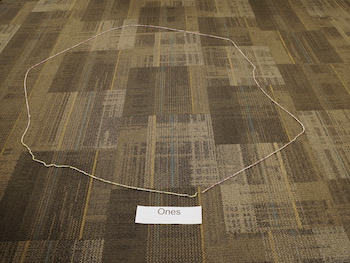
Teacher: I made circles on the floor with yarn. (Walk to the circle closest to the wall and place the “ones” vocabulary card in front of the circle.) What does ones mean? (A single unit or object.) In this circle we will represent the ones using axial movements that are percussive. I will select one part of my body to move, and I will only move that one part of my body in a percussive way.
Model a percussive movement, such as jabbing one hand, bending one knee, twisting the torso, and so on.
Teacher: We will start dancing one student at a time, according to the number cards we each have and starting with number one. When number one is called, the student who is holding the card with that number needs to stand up, hand me his or her number card, then go inside the ones circle and do an axial movement with one part of the body that is percussive. When I call the student who has number two, that student also hands me his or her number card and then joins the first student in the circle. Student two needs to pay attention to the movement the first student does, because that student will add his or her own different, percussive movement using another part of the body.
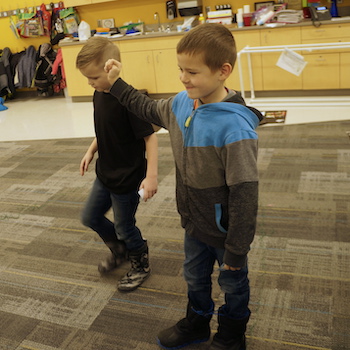
Teacher: Does this remind you of any patterns we’ve used to model ones (the beat on the drum)? While you’re waiting for your number to be called, watch the other movements made by your friends. You need to be thinking of a new movement that no one else is doing.
Student two comes up and selects an axial movement that is different than student one’s. Remind the students that they must find another way to move their bodies than what is already being performed within the circle. Continue adding students three through nine, one at a time. Each student should create unique movements.
Moving as Tens
Teacher: Can we add any more students to our ones circle? No! Just like the drum and the trays of fish, we can only have nine in our ones circle. When we have ten, we are going to move from the ones circle to the tens circle. Instead of axial, percussive movements, we will use locomotor, sustained movements to move. Number ten will circle around the ones, keeping any other ones from adding to our group. Ten will lead the rest of the group from the ones circle to the tens circle. Instead of each person in the circle doing their own individual movements, students one through nine copy whatever movements number ten is doing.
Demonstrate by being number ten and leading the ones group to the tens circle. Then lead them back to the ones circle.
Teacher: Can you tell the difference between the ones dance and the tens dance? The ones get to dance as individuals, but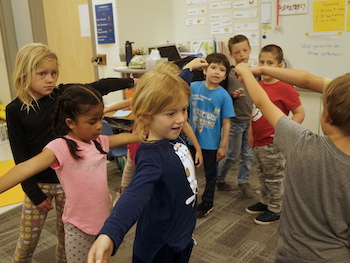
Invite students one to nine to start doing their percussive, axial movements again. Have student ten start dancing smooth, flowing, sustained locomotor movements while encircling the group. Students begin copying number ten’s movements as they are led to the tens circle. Play the glockenspiel by sliding (glissando) across the bars in a steady beat as an accompaniment for the students to dance to.
Tens and Ones Together
Teacher: What do you think student 11 is going to do? Any ideas? (Listen for student responses.) The ones circle is now empty, so we can use that circle and begin the ones dance again using individual, percussive axial movements.
The 11th student moves to the ones circle and begins a new movement. Students 12–19 join one at a time with unique movements. Students one through ten continue to dance following student ten’s smooth, sustained locomotor movements. If possible, play both the drum and the glockenspiel on the steady beat (one mallet in each hand), or alternate between playing the glockenspiel and the drum on every other beat, to help students move together.
Teacher: Following the pattern we have already seen, what do you think will happen when student 20 joins our dance? Can he join the ones circle? Is there room? No! What about leading his group of ten to the tens circle students one to ten are in? That won’t work either. Remember when we had boxes or cups of fish? Only ten fish could be in a cup. With each new group of ten, we had to get a new cup. In that same way, there can only be ten students in one tens circle, but we have another circle over here he could lead his group of ten to.
The 20th student leads students 11–19 using sustained locomotor movements different from those of the tenth students, while guiding his group to the third yarn circle, so there are now two groups of ten. Play the glockenspiel on the steady beat to accompany student movement.
Teacher: Students, freeze. Let’s count how many students have been dancing.
Count by tens first by saying there are two tens, then as ten, 20. Count again by ones.
Teacher: There are still others who haven’t started dancing yet. Where should they go to move? Why?
With the remaining students, repeat the process until all are dancing.
Writing Numbers
Review the process of creating the dance with the students.
Teacher: What happened when student ten came up? How did the movement change and why? What happened when student 20 was called? Why did he move into a new circle?
Have students retrieve their whiteboards. Use the number cards and pull out random numbers to discuss as a class. The number nine is used as an example.
Teacher: If I were to write on my board __________tens and _____________ones, where would the number nine belong? (Model on a whiteboard as you ask the question.) Yes, in the blank space in front of the ones. I would like all of you to write that on your boards, just like I did.
Watch to make sure they are placing the number nine in the ones space.
Teacher: Now fill in the number sentence _____0_____+_____9_____=_____9_____
As I continue to pull numbers, I want you to model writing the number using tens and ones.
Call out and show a few other number cards, possibly including 10, 14, 19, 3, and 20 (include at least one or two numbers showing ones, one or two numbers showing teens, and one or two numbers showing twenties), so that the children have practice with multiple ways of making the numbers.
Make sure to include the sentence frames:
________tens _________ones
__________+__________=__________
Extensions
- Quick Draw: Ask students to create the number as a “quick draw,” with long, vertical lines representing the tens and dots representing the ones.
- Classical Music: Repeat dance vocabulary and movements for review. Have students listen to classical music and determine axial, percussive movements, or as tens with sustained, locomotor movements based on whether the music is smooth, sustained sounding or percussive sounding. Whenever it is time to move as tens, have them face a certain direction and follow the person closest to the wall (flocking), so they move together as a group, reinforcing that tens are a group and ones are individuals. Switch back and forth between pieces to challenge students in their listening and movement.
Suggested music pieces include Sergei Rachmaninov’s Rhapsody on a Theme of Paganini (both the 18th variation [sustained] and the 19th variation [percussive]) and Camille Saint-Saëns’s “Kangaroos” from Carnival of the Animals.- The 18th variation is known for its soaring melody.
- The 19th variation has been referred to as pointillistic and could be another tie-in with the pointillism lesson.
- "Kangaroos"
- The music terms staccato and legato are introduced in the lesson “Waddling Ones and Tobogganing Tens.” It might be effective to wait to do this extension until after that lesson is taught, because the students are listening for legato and staccato sounds in the music.
- Numbers in the Hundreds: There will not be classes with over 100 students, so when exploring movement to represent these numbers, the dance cannot be as literal. After students have explored how to represent tens and ones, explain that a few of the students are going to represent hundreds as well. Those students will move in pathways around the perimeter of the room. The pathways could be straight, curved, or zig-zag, or students might come up with additional pathways they want to try.
Learning Objectives
- Create a physical model of mathematics concepts with bodies.
- Understand that ten can be thought of as a group of ten ones, called a "ten."
- Understand that numbers can have a ten as well as ones.
- Demonstrate axial and locomotor movements.
- Demonstrate percussive and sustained movements.
- Explain how movements represent place-value concepts.
Utah State Board of Education Standards
This lesson can be used to meet standards in many grades and subject areas. We will highlight one grade’s standards to give an example of application.
Grade 1 Mathematics
- Standard 1.MP.4: Model with mathematics. Identify the mathematical elements of a situation and create a mathematical model that shows the relationships among them. Identify important quantities in a contextual situation, use mathematical models to show the relationships of those quantities, analyze the relationships, and draw conclusions. Models may be verbal, contextual, visual, symbolic, or physical.
- Standard 1.MP.7: Look for and make use of structure. Recognize and apply the structures of mathematics such as patterns, place value, the properties of operations, or the flexibility of numbers. See complicated things as single objects or as being composed of several objects.
- Standard 1.NBT.2: Understand that the two digits of a two-digit number represent amounts of tens and ones. Understand the following as special cases:
- 10 can be thought of as a bundle of ten ones, called a "ten."
- The numbers from 11 to 19 are composed of a ten and one, two, three, four, five, six, seven, eight, or nine ones.
- The numbers 10, 20, 30, 40, 50, 60, 70, 80, 90 refer to one, two, three, four, five, six, seven, eight, or nine tens (and 0 ones).
Grade 1 Dance
- Standard 1.D.CR.2: Explore movement inspired by a variety of stimuli.
- Standard 1.D.P.1: Demonstrate moving safely through the space using a range of activities and in and out of spatial arrangements while maintaining personal space.
- Standard 1.D.P.4: Demonstrate locomotor and non-locomotor movements.
- Standard 1.D.P.6: Demonstrate a variety of movement qualities while dancing.
- Standard 1.D.R.1: Select movements from a dance, and explain how the movements suggest an idea.
- Standard 1.D.CO.2: Describe and demonstrate movements organized around a specific topic.
Equipment and Materials Needed
- Two different colors of string cut into three very long pieces, long enough for groups of up to nine students to move inside.
- Number cards from one to 24 (or more depending on class size, but at least greater than 20)
- Drum with a mallet
- Glockenspiel
- Whiteboards, dry-erase markers, and erasers for every student OR paper and a pencil for every student
- Vocabulary word cards: axial, locomotor, percussive, sustained, ones, tens
Additional Resources
- This lesson is part of a unit using the arts to teach place value. The lessons can be found on the BYU ARTS Partnership website. The titles include the following:
Image References
Images 1-3: Dianne Amesse.
Images 4–5: Emily Soderborg.
Images 6: Dianne Amesse.
Images 7–8: Emily Soderborg.

www.education.byu.edu/arts/lessons
 Download
Download
